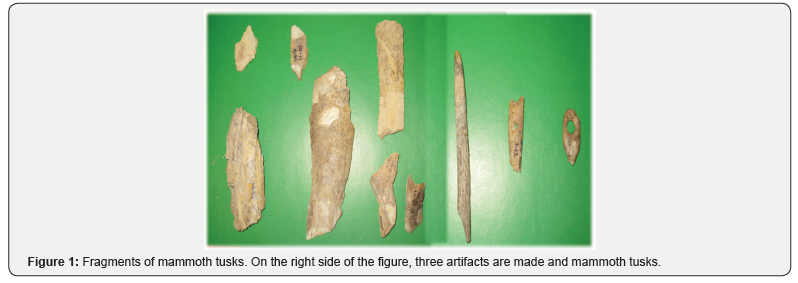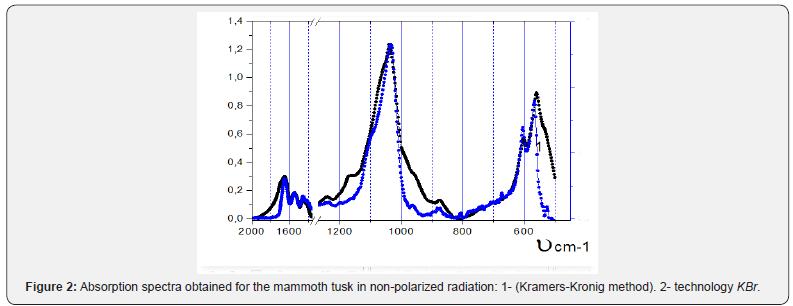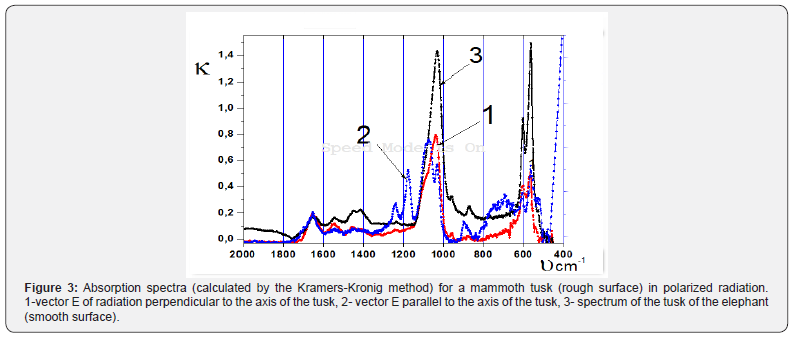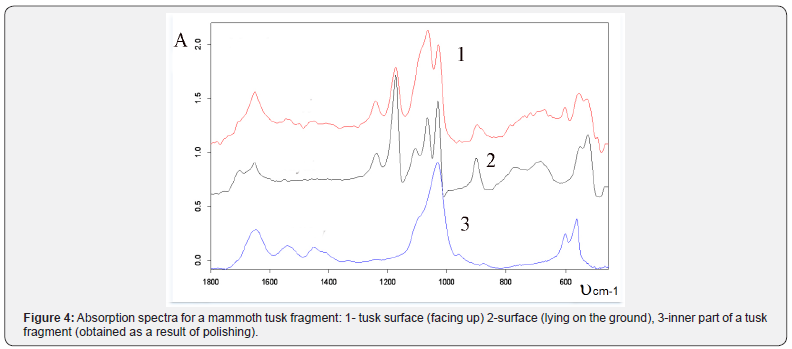Investigation of Mammoth Tusks from the Paleolithic Sites of the European Part of Russia by the IR Reflection Spectroscopy- Juniper Publishers
Archaeology & Anthropology- Juniper Publishers
Abstract
Based on the optical model of a porous rough surface
typical of archeological and paleontological objects, the mathematical
processing of
the infrared (IR) reflection spectra of such objects was performed and
the frequencies in the IR reflection spectra of objects with a rough
surface
were identified. Examples of research by the non-destructive method of
IR spectra of mirror reflection of mammoth tusks from two Paleolithic
sites (14,000 and 16,000 BC), pos. Yudinovo, Bryansk region, Russia. The
results are compared with traditional methods of diffuse infrared
reflection and the KBr technique.
Keywords: IR reflection spectroscopy; Mammoth tusks
Introduction
Objects of archeology and paleontology are mainly investigated
using the destructive method of the KBr technique or diffuse IR
reflection. In some cases, when the question concerns the study of
objects of a sacral nature, this technique cannot be used. A possible
way out of this situation is the use of the method of mirror IR
reflection. However, the uneven and rough surface of real objects
complicates the mathematical processing of such measurements.
In [1], an optical model of the rough surface of a real object
typical of archeology and paleontology [2,3] was considered.
To implement this model, data on the optical properties of the
object in the IR spectral region are needed. Since the basis of
objects (fragments of mammoth tusks) of paleontology includes
the mineral apatite Ca5(PO4)3(OH), its spectral absorption
characteristics were determined in the range of 6-28 microns
[4]. This made it possible to correctly process the IR spectra of
the specular reflection of several objects (fragments of mammoth
tusks) [1]. In [5] a comparison was made of the sensitivity of
nondestructive methods of specular and diffuse reflection. In the
latter method, the sample was prepared in two ways [5-8].
a. Was ground into a fine powder and placed in transparent
immersion medium.
b. Was investigated in the mode of in situ.
Research Results
Objects of investigation [1] were obtained from the holdings
of the Museum of Anthropology and Ethnography of the Russian
Academy of Sciences. The specimens were predominantly slivers
split off from mammoth tusks used in household activities of
ancient people and artifacts (Figure 1) decorated with carved
rhombic ornaments, which were found upon excavation at two
paleolithic sites that are situated in Yudinovo (Bryansk oblast,
Russia). The sites are from two different archeological time
periods and have similar lithic industries of bone processing; at
each of them, a vast collection of stone and bone implements was
excavated, especially artifacts made of mammoth tusks, which were
used for making hunting weapons, navy tools, decorations, and
other household needs [2,3]. The multiplicity and diversity of tusk
implements from the Yudinovo sites and their good preservation
and assignments to different chronological habitation levels of
ancient people create a good basis for verification and subsequent
application of nondestructive IR reflection spectroscopy methods
to the solution of a series of archeological problems related with
climatic habitation conditions, as well as with the sedentism and
duration of occupation of paleolithic sites.

Main conclusion
It is generally accepted to divide specimens of mammoth tusks
found in archeological excavations into three groups differing in
the conditions under which they were found. Specimens of the first
group were found on the “daytime” surface of the site, specimens
of the second group were found inside “dwellings,” and specimens
of the third group were concealed in “household” pits of different
designations. Most specimens chosen for investigation belong to
the first group. These specimens are bent split plates of mammoth
tusk of a cylindrical shape. All the specimens found were cleaned
from soil and sediments with brush, washed with fresh water, and
dried. Dating for the upper (14000 BCE) and lower (16000 BCE)
paleolithic sites, which were located at horizons of 2 and 4 m from
the ground surface, respectively, was performed with carbon 14C
radioisotope analysis. For comparison, radioisotope analysis was
also performed for pieces that were cut from whole mammoth
tusks that were obtained from Eastern Siberia (Yakutia), which
are used in restoration works and which were in a very good
condition upon visual examination and had a whitish light-yellow
cream-colored hue (which is an indication of good preservation
of the object.


In generalizing the results of application of the IR reflection
spectroscopy method to the investigation of mineralization
process of mammoth tusks, we should note that the optical model
of a porous surface that was proposed in the first part of this work
forms guidelines for correct mathematical processing of spectra,
which makes it possible to extract reliable data on frequencies
in the vibrational spectrum of the object. Figure 2 shows a
comparison of the normalized absorption spectra for a fragment
of a mammoth’s tusk, obtained by the traditional KBr(powder)
method and specular reflection without disturbing the surface
(method Kramers-Kronig). Useful information can be obtained
from the analysis of the spectra of oriented tusk fragments in
polarized radiation (Figure 3).
Useful information Figure 4 can be obtained from the analysis
of the spectra of fragments from the location of the fragment and
from its location on this site. The sample is oriented relative to the
surface of the earth. The side of the fragment that is in contact with
the ground is internal, and the opposite side is external. It follows
from our studies of the IR reflection spectra of mammoth tusks
that the specimens of the first group are characterized by only
one basic mineralization process [9]. This process proceeds both
in the volume and, more actively, on the surface of the specimen.
Taking into account that, in accordance with the IR spectroscopy
data, the content of СаСО3 in the specimens of the first group from
the upper layer of the soil is, on average, higher than in the lower
layer and taking into account mineralization processes strongly
depend on the temperature, humidity, and concentration of СО2
of the Earth’s atmosphere, it follows from these investigations
that the above listed external factors noticeably increased in
magnitude during the time of existence of the upper site of ancient
people.

These conclusions correlate well with results of geophysical
investigations [10], which indicate that, in the period of existence
of the lower and upper paleolithic sites (Yudinovo, Bryansk
oblast, Russia), there occurred an increase in the temperature
of the surface of the Earth and, correspondingly, in the humidity,
as well as in the concentration of СО2 in the Earth’s atmosphere.
For specimens of the third group, the first stage of mineralization
is supplemented by the bioprocess, which proceeds only on
the surface. The competition between these two processes of
destruction of mammoth tusks depends on the biochemical
conditions experienced by the specimen at the initial period,
because these conditions determine the biological activity of
microorganisms involved in assimilation of compounds of the
surface layer.
Considering that the time period during which the bio
destruction proceeds is comparatively short compared to the
entire time of burial of the object in the ground, the IR spectrum
allows one to obtain information on the conditions of the bio
destruction stage, which is tied to the radiocarbon time mark. In
conclusion, we can state that the proposed optical model for the
description of the IR reflection spectra of bones makes it possible
to process in situ the spectra of real objects with nonfat and rough
surfaces. It is significant that the properties of the volume and
surface of bones can be very different, which yields additional
information on external and local factors that affect mineralization
processes in specimens for different time conditions, which, in
particular, were realized for the upper and lower paleolithic sites
at Yudinovo. For spectroscopic studies of objects from different
archeological layers, it is expedient to additionally classify objects
according to the conditions of their orientation with respect to the
ground surface upon excavation and to indicate the ground water
level in places of their discovery in the legend of specimens.
To know more about Journal of Archaeology and Anthropology: https://juniperpublishers.com/gjaa/index.php




Comments
Post a Comment